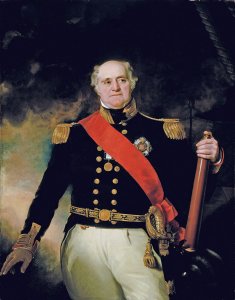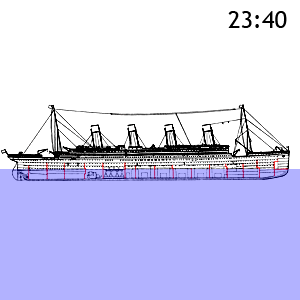Today in Naval History - Naval / Maritime Events in History
28th of March
some of the events you will find here,
please use the following link where you will find more details and all other events of this day .....
1599 – Birth of Witte Corneliszoon de With (28 March 1599 – 8 November 1658), a famous Dutch naval officer of the 17th century

1693 – Launch of HMS Portland, a 50-gun fourth rate ship of the line of the Royal Navy, at Woolwich Dockyard
She was rebuilt according to the 1719 Establishment at Portsmouth, and was relaunched on 25 February 1723.
She was present at Wager's Action a naval confrontation on 8 June 1708 N.S (28 May O.S.), between a British squadron under Charles Wager and the Spanish treasure fleet, as part of the War of Spanish Succession.

Wager's Action off Cartagena, 28 May 1708
1693 – Launch of HMS Norfolk, an 80-gun third rate ship of the line of the Royal Navy, at Southampton
HMS Norfolk was an 80-gun third rate ship of the line of the Royal Navy. She was built at Southampton and launched on 28 March 1693, and was the first ship to bear the name. She was rebuilt at Plymouth according to the 1719 Establishment, and was re-launched on 21 September 1728. Instead of carrying her armament on two decks as she had done originally, she now carried them on three gundecks, though she continued to be rated a third rate.

1777 – The Battle off Yarmouth took place on 28 March 1777 during the American Revolutionary War off the coast of Yarmouth, Nova Scotia.
The Battle off Yarmouth took place on 28 March 1777 during the American Revolutionary War off the coast of Yarmouth, Nova Scotia. The battle is the first American armed vessel to engage the British Navy. The British vessel HMS Milford forced the American USS Cabot aground and the American crew escaped among the inhabitants of Yarmouth.
1785 – Launch of HMS Terrible, a 74-gun third rate ship of the line of the Royal Navy, at Rotherhithe.
In December 1813 she was paid off and placed in ordinary at Sheerness Dockyard. She remained out of service until 1829, other than a nine-month period between August 1822 and May 1823 when she acted as a receiving ship for volunteers and pressed men. From 1829 to 1836 she served as a coal depot for Navy steamships. Declared surplus even to this limited requirement, she was brought to Deptford Dockyard and broken up in March 1836.

1806 - HMS Niobe (38), Cptn. J. W. Loring, captured French corvette Nearque (16) off L'Orient
The French brig Néarque was an Abeille-class brig launched at Lorient in 1804. She made a voyage to the Caribbean in 1805. After the frigate HMS Niobe captured her in March 1806, the Royal Navy took her into Plymouth, but apparently laid her up in ordinary. She then disappears from the records until her sale in 1814.


From ancre is a beautiful monographie of the Cygne 1804 Jean BOUDRIOT & Hubert BERTI available
1814 – War of 1812: In the Battle of Valparaíso, two American naval vessels are captured by two Royal Navy vessels of equal strength.
HMS Phoebe (36) and HMS Cherub (18) under Cptn. James Hillyar capture USS Essex (46), Cptn. David Porter, off Valparaiso, Chile.
The Battle of Valparaíso, also called the Capture of USS Essex, was a naval action fought during the War of 1812. It took place off Valparaíso, Chile on March 28, 1814 between the frigate USS Essex and the sloop USS Essex Junior of the United States Navyand the frigate HMS Phoebe and sloop HMS Cherub of the Royal Navy. The British ships won the battle, and the American vessels were captured.

1815 – Launch of HMS Howe, a 120-gun first-rate ship of the line of the Royal Navy, at Chatham.
Howe was broken up in 1854.

1861 – Launch of French ironclad Couronne ("Crown"), the first iron-hulled ironclad warship built for the French Navy in 1859–62.
She was the first such ship to be laid down, although the British armoured frigate HMS Warrior was completed first.
The French ironclad Couronne ("Crown") was the first iron-hulled ironclad warship built for the French Navy in 1859–62. She was the first such ship to be laid down, although the British armoured frigate HMS Warrior was completed first. The ship participated in the Franco-Prussian War of 1870–71, but saw no combat. She was served as a gunnery training ship from 1885 to 1908 before she was hulked the following year and became a barracks ship in Toulon. Couronne was scrapped in 1934, over 70 years after she was completed.

1896 – Launch of USS Iowa (BB-4), a United States Navy battleship
USS Iowa (BB-4) was a United States Navy battleship. Launched in 1896, it was the first ship commissioned in honor of Iowa and was America's first seagoing battleship. Iowa saw substantial action in the Spanish–American War. While she was an improvement over the Indiana class because of a superior design, the warship became obsolete quickly in the first quarter of the 20th century and was used for target practice and sunk on 23 March 1923 in Panama Bay by a salvo of 14-inch shells

1914 – Launch of Fusō (扶桑, a classical name for Japan), the lead ship of the two Fusō-class dreadnought battleships built for the Imperial Japanese Navy.
Fusō (扶桑, a classical name for Japan) was the lead ship of the two Fusō-class dreadnought battleships built for the Imperial Japanese Navy. Launched in 1914 and commissioned in 1915, she initially patrolled off the coast of China, playing no part in World War I. In 1923, she assisted survivors of the Great Kantō earthquake.

28th of March
some of the events you will find here,
please use the following link where you will find more details and all other events of this day .....
Naval/Maritime History - 28th of March - Today in Naval History - Naval / Maritime Events in History
Today in Naval History - Naval / Maritime Events in History 27 March 1666 – Launch of HMS Defiance, a 64-gun third rate ship of the line of the English Royal Navy, HMS Defiance was a 64-gun third rate ship of the line of the English Royal Navy, ordered on 26 October 1664 under the new...
shipsofscale.com
1599 – Birth of Witte Corneliszoon de With (28 March 1599 – 8 November 1658), a famous Dutch naval officer of the 17th century

1693 – Launch of HMS Portland, a 50-gun fourth rate ship of the line of the Royal Navy, at Woolwich Dockyard
She was rebuilt according to the 1719 Establishment at Portsmouth, and was relaunched on 25 February 1723.
She was present at Wager's Action a naval confrontation on 8 June 1708 N.S (28 May O.S.), between a British squadron under Charles Wager and the Spanish treasure fleet, as part of the War of Spanish Succession.
Wager's Action off Cartagena, 28 May 1708
1693 – Launch of HMS Norfolk, an 80-gun third rate ship of the line of the Royal Navy, at Southampton
HMS Norfolk was an 80-gun third rate ship of the line of the Royal Navy. She was built at Southampton and launched on 28 March 1693, and was the first ship to bear the name. She was rebuilt at Plymouth according to the 1719 Establishment, and was re-launched on 21 September 1728. Instead of carrying her armament on two decks as she had done originally, she now carried them on three gundecks, though she continued to be rated a third rate.
1777 – The Battle off Yarmouth took place on 28 March 1777 during the American Revolutionary War off the coast of Yarmouth, Nova Scotia.
The Battle off Yarmouth took place on 28 March 1777 during the American Revolutionary War off the coast of Yarmouth, Nova Scotia. The battle is the first American armed vessel to engage the British Navy. The British vessel HMS Milford forced the American USS Cabot aground and the American crew escaped among the inhabitants of Yarmouth.
1785 – Launch of HMS Terrible, a 74-gun third rate ship of the line of the Royal Navy, at Rotherhithe.
In December 1813 she was paid off and placed in ordinary at Sheerness Dockyard. She remained out of service until 1829, other than a nine-month period between August 1822 and May 1823 when she acted as a receiving ship for volunteers and pressed men. From 1829 to 1836 she served as a coal depot for Navy steamships. Declared surplus even to this limited requirement, she was brought to Deptford Dockyard and broken up in March 1836.
1806 - HMS Niobe (38), Cptn. J. W. Loring, captured French corvette Nearque (16) off L'Orient
The French brig Néarque was an Abeille-class brig launched at Lorient in 1804. She made a voyage to the Caribbean in 1805. After the frigate HMS Niobe captured her in March 1806, the Royal Navy took her into Plymouth, but apparently laid her up in ordinary. She then disappears from the records until her sale in 1814.
From ancre is a beautiful monographie of the Cygne 1804 Jean BOUDRIOT & Hubert BERTI available
1814 – War of 1812: In the Battle of Valparaíso, two American naval vessels are captured by two Royal Navy vessels of equal strength.
HMS Phoebe (36) and HMS Cherub (18) under Cptn. James Hillyar capture USS Essex (46), Cptn. David Porter, off Valparaiso, Chile.
The Battle of Valparaíso, also called the Capture of USS Essex, was a naval action fought during the War of 1812. It took place off Valparaíso, Chile on March 28, 1814 between the frigate USS Essex and the sloop USS Essex Junior of the United States Navyand the frigate HMS Phoebe and sloop HMS Cherub of the Royal Navy. The British ships won the battle, and the American vessels were captured.
1815 – Launch of HMS Howe, a 120-gun first-rate ship of the line of the Royal Navy, at Chatham.
Howe was broken up in 1854.
1861 – Launch of French ironclad Couronne ("Crown"), the first iron-hulled ironclad warship built for the French Navy in 1859–62.
She was the first such ship to be laid down, although the British armoured frigate HMS Warrior was completed first.
The French ironclad Couronne ("Crown") was the first iron-hulled ironclad warship built for the French Navy in 1859–62. She was the first such ship to be laid down, although the British armoured frigate HMS Warrior was completed first. The ship participated in the Franco-Prussian War of 1870–71, but saw no combat. She was served as a gunnery training ship from 1885 to 1908 before she was hulked the following year and became a barracks ship in Toulon. Couronne was scrapped in 1934, over 70 years after she was completed.
1896 – Launch of USS Iowa (BB-4), a United States Navy battleship
USS Iowa (BB-4) was a United States Navy battleship. Launched in 1896, it was the first ship commissioned in honor of Iowa and was America's first seagoing battleship. Iowa saw substantial action in the Spanish–American War. While she was an improvement over the Indiana class because of a superior design, the warship became obsolete quickly in the first quarter of the 20th century and was used for target practice and sunk on 23 March 1923 in Panama Bay by a salvo of 14-inch shells
1914 – Launch of Fusō (扶桑, a classical name for Japan), the lead ship of the two Fusō-class dreadnought battleships built for the Imperial Japanese Navy.
Fusō (扶桑, a classical name for Japan) was the lead ship of the two Fusō-class dreadnought battleships built for the Imperial Japanese Navy. Launched in 1914 and commissioned in 1915, she initially patrolled off the coast of China, playing no part in World War I. In 1923, she assisted survivors of the Great Kantō earthquake.





